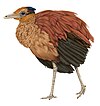孔子鳥科
| 孔子鳥科 化石時期:下白堊紀
| |
|---|---|

| |
| 聖賢孔子鳥(Confuciusornis sanctus)的化石標本 | |
| 科學分類 | |
| 界: | 動物界 Animalia |
| 門: | 脊索動物門 Chordata |
| 演化支: | 鳥翼類 Avialae |
| 演化支: | 真鳥翼類 Euavialae |
| 演化支: | 短尾鳥類 Avebrevicauda |
| 演化支: | 尾綜骨鳥類 Pygostylia |
| 目: | †孔子鳥目 Confuciusornithiformes |
| 科: | †孔子鳥科 Confuciusornithidae Hou et al., 1995 |
| 屬 | |
孔子鳥科(學名:Confuciusornithidae)是中國下白堊紀的一科原始鳥類,由4個屬組成,化石形成於1億3100萬-1億2000萬年前。
分類[編輯]
孔子鳥目共有1科4屬5種被確認,而錦州鳥的有效性仍有爭議,另有數個屬可能也屬於孔子鳥目。在已知的孔子鳥類中,鄭氏始孔子鳥是生存年代最早者。
- ?葉夫根鳥屬 Evgenavis
- ?高貴葉夫根鳥 Evgenavis nobilis
- 「前鳥屬」 "Proornis"
- 「朝鮮前鳥」 "Proornis coreae"
- ?中鳥屬 Zhongornis
- ?郝氏中鳥 Zhongornis haoae
- 孔子鳥科 Confuciusornithidae
孔子鳥科由侯連海等人(Hou et al.)於1995年命名,包含模式屬孔子鳥屬,並被劃分至鳥綱孔子鳥目。[2]這一類群由Chiappe於1999年給出了種系發生學定義,他將基於節點的分支孔子鳥科(Confuciusornithidae)定義為只包含長城鳥和孔子鳥的一科。[3]Sereno這一定義擴大,將所有親緣關係與聖賢孔子鳥(Confuciusornis sanctus)更近、與家麻雀(Passer domesticus)相對較遠的物種都包含在孔子鳥科中。[4]錦州鳥由侯連海、周忠和及張福成於2002年被加至孔子鳥科[5],而始孔子鳥由張福成、周忠和及麥可·本頓於2008年被歸入孔子鳥科。[6]
體表特徵[編輯]
大約半數的保留有羽毛的孔子鳥科(包括所有物種的代表種)標本都擁有一對與眾不同的絲帶狀尾羽,而且羽毛既可能是有羽軸的正羽,也可能是不帶羽軸的絨羽。[3][6]
注釋[編輯]
- ^ Wang, M.; O'Connor, J.; Zhou, Z.-H. A taxonomical revision of the Confuciusornithiformes (Aves: Pygostylia) [孔子鳥目(鳥類:尾綜骨類)的分類釐定] (PDF). 古脊椎動物學報. 2019, 57 (1): 1–37 [2019-10-11]. ISSN 1000-3118. doi:10.19615/j.cnki.1000-3118.180530. (原始內容存檔 (PDF)於2019-01-16).
- ^ Hou, L. et. al (1995)
- ^ 3.0 3.1 Chiappe, Luis M. et. al (1999)
- ^ Sereno, P. C. (2005)
- ^ Hou, L. H., Zhou, Z. H., & Zhang, F. C. (2002)
- ^ 6.0 6.1 Zhang, F. -C., Zhou, Z. -H., & Benton, M. J. (2008)
參考文獻[編輯]
- Chiappe, Luis M.; Shu-An, Ji; Qiang, Ji; Norell, Mark A. Anatomy and systematics of the Confuciusornithidae (Theropoda:Aves) from the Late Mesozoic of northeastern China. Bulletin of the American museum of Natural History. 1999, 242: 89.
- Hou, L.; Zhou, Z.; Gu, Y.; Zhang, H. Description of Confuciusornis sanctus. Chinese Science Bulletin. 1995, 10: 61–63.
- Hou, L. H.; Zhou, Z. H.; Zhang, F. C.; et. al. Mesozoic Birds from Western Liaoning in China. Shenyang, China: Liaoning Science and Technology Publishing House. 2002.
- Sereno, P. C. Stem Archosauria—TaxonSearch. 2005 [7 Jul 2009]. (原始內容存檔於2009-01-15).
- Zhang, F. -C.; Zhou, Z. -H.; Benton, M. J. A primitive confuciusornithid bird from China and its implications for early avian flight.. Science in China Series D: Earth Sciences. 2008, 51 (5): 625–639.
| ||||||||||||||||||||||||||||||||||||||||||||||||||||||||||||||||||||||||||||||||||||||||||||||||||||||||||||||||||||||||||||||||||||||||||||||||||||||||||||||||||||||||||||||||||||||||||||||||||||||||||||||||||||||||||||||||||||||||||||||||||||||||||||||||||||||||||||||||||||||||||||||||||||||||||||||||||||||||||||||||||||||||||||||||||||||||||||||||||||||||||||||||||||||||||||||||||||||||||||||||||||||||||||||||||||||||||||||||||||||||||||||||||||||||||||||||||||||||||||||||||||||||||||||||||||||||||||||||||||||||||||||||||||||||||||||||||||||||||||||||||||||||||||||||||||||||
|























